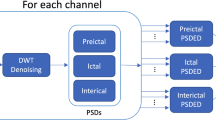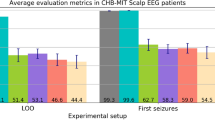Abstract
The objective of this study is to propose an approach to detect Seizure and Non-Seizure phenomenon from the highly inconsistent and non-linear EEG signals. In the view of performing cross-subject classification over the inconsistency and non-linear characteristics of EEG signals, we have proposed a fine-tuned Capsule Neural Network (CapsNet) based approach to classify the seizure and non-seizure EEG signals through subject specific and cross-subject training and testing. In this experiment, first we have normalized the input data using L2 normalization technique. In the second step, the normalized data have been given to the CapsNet and model level fine-tuning has been carried out. In addition to this, we have performed seizure and non-seizure classification performance evaluation using three more classifiers such as Decision Tree, Logistic Regression, Convolutional Neural Network to compare with the performance of the proposed approach. To estimate the effectiveness of the proposed approach, subject specific and cross-subject training and testing have been performed. In both experiments, we have used multi-channel and single channel EEG datasets. For subject specific experiment, the proposed approach achieved a mean accuracy of 93.50% over the dataset-1 (multi-channel) and an accuracy of 82.61% for dataset-2 (single channel). For cross-subject experiment, the proposed approach achieved a highest mean accuracy of 86.41% over the dataset-1(multi-channel) and a mean accuracy of 48.45% over the dataset-2 (single channel) which shows an advantage of CapsNet in a certain data scenario as described in result section. Overall performance of the proposed approach shown a comparable improvement over the existing approaches.



















Similar content being viewed by others
Data availability
Experimental datasets used in this proposed approach are publicly available is at https://physionet.org/content/chbmit/1.0.0/ (CHB-MIT scalp EEG dataset) and https://repositori.upf.edu/handle/10230/42894 (University of Bonn, EEG time series dataset).
References
Abdelhameed A, Bayoumi M (2021) A deep learning approach for automatic seizure detection in children with epilepsy. Front Comput Neurosci 15:650050. https://doi.org/10.3389/fncom.2021.650050
Acharya UR, Oh SL, Hagiwara Y, Tan JH, Adeli H (2018) Deep convolutional neural network for the automated detection and diagnosis of seizure using EEG signals. Comput Biol Med 100:270–278. https://doi.org/10.1016/j.compbiomed.2017.09.017
Andrzejak RG, Lehnertz K, Mormann F, Rieke C, David P, Elger CE (2001) Indications of nonlinear deterministic and finite-dimensional structures in time series of brain electrical activity: dependence on recording region and brain state. Phys Rev E 64:061907. https://doi.org/10.1103/PhysRevE.64.061907
Bhattacharyya A, Pachori RB (2017) A multivariate approach for patient-specific EEG seizure detection using empirical wavelet transform. IEEE Trans Biomed Eng 64:2003–2015. https://doi.org/10.1109/TBME.2017.2650259
Bisong E (2019) Google Colaboratory, building machine learning and deep learning models on Google cloud platform. Apress, Berkeley, CA
Chao H, Dong L, Liu Y, Lu B (2019) Emotion recognition from multiband EEG signals using CapsNet. Sensors 19:2212. https://doi.org/10.3390/s19092212
CHB-MIT Scalp EEG dataset, https://physionet.org/content/chbmit/1.0.0/. Accessed: 27 Jan 2023
Chen S, Zhang X, Chen L, Yang Z (2019) Automatic diagnosis of epileptic seizure in electroencephalography signals using nonlinear dynamics features. IEEE Access 7:61046–61056. https://doi.org/10.1109/ACCESS.2019.2915610
Chernecky CC, Berger BJ (2013) laboratory tests and diagnostic procedures. 6th ed, Elsevier, ISBN 9781455706945
Chiang H-S, Chen M-Y, Huang Y-J (2019) Wavelet-based EEG processing for epilepsy detection using fuzzy entropy and associative petri net. IEEE Access 7:103255–103262. https://doi.org/10.1109/ACCESS.2019.2929266
Colaboratory: Frequently Asked Questions, https://research.google.com/colaboratory/faq.html. Accessed: 27 Jan 2023
Cole TJ (1991) Applied logistic regression. D. W. Hosmer and S. Lemeshow, Wiley, New York, 1989. No. of pages: xiii + 307. Price: £36.00. Stat Med 10:1162–1163. https://doi.org/10.1002/sim.4780100718
Constantino TM, What’s the Difference Between a Seizure and Epilepsy? In: intermountainhealthcare.org. https://intermountainhealthcare.org/blogs/topics/live-well/2017/12/whats-the-difference-between-a-seizure-and-epilepsy/. Accessed 27 Jan 2023
Department of Epileptology, University of Bonn, EEG time series download page, https://repositori.upf.edu/handle/10230/42894. Accessed 27 Jan 2023
EEG (Electroencephalogram)-Epilepsy Society. https://epilepsysociety.org.uk/about-epilepsy/diagnosing-epilepsy/electroencephalogram-eeg. Accessed 27 Jan 2023
Eldor T, Capsule Neural Networks – Part 2, https://towardsdatascience.com/capsule-neural-networks-part-2-what-is-a-capsule-846d5418929f. Accessed 27 Jan 2023
Emami A, Kunii N, Matsuo T, Shinozaki T, Kawai K, Takahashi H (2019) Seizure detection by convolutional neural network-based analysis of scalp electroencephalography plot images. NeuroImage: Clin 22:101684. https://doi.org/10.1016/j.nicl.2019.101684
Engel J, Pedley TA (2008) Epilepsy: a comprehensive textbook, 2nd edn. Wilkins, Wolters Kluwer Health/Lippincott Williams &
Epilepsy, factsheet - World Health Organization, (9th February 2022), https://www.who.int/en/news-room/fact-sheets/detail/epilepsy. Accessed 27 Jan 2023
Gajic D, Djurovic Z, Gligorijevic J, di Gennaro S, Savic-Gajic I (2015) Detection of epileptiform activity in EEG signals based on time-frequency and non-linear analysis Front Comput Neurosci 9. https://doi.org/10.3389/fncom.2015.00038
Goodfellow I, Bengio Y, Courville A (2016) Convolution neural network, deep learning 321–359. MIT press
Gu J, Wang Z, Kuen J, Ma L, Shahroudy A, Shuai B, Liu T, Wang X, Wang G, Cai J, Chen T (2018) Recent advances in convolutional neural networks. Pattern Recogn 77:354–377. https://doi.org/10.1016/j.patcog.2017.10.013
Xifeng Guo, A Keras implementation of CapsNet, Dynamic Routing Between Capsules, https://github.com/XifengGuo/CapsNet-Keras. Accessed 27 Jan 2023
Guo J, Fang F, Wang W, Ren F (2018) EEG emotion recognition based on granger causality and CapsNet neural network. 5th IEEE international conference on cloud computing and intelligence systems (CCIS) 47–52, IEEE, Nanjing, China. https://doi.org/10.1109/CCIS.2018.8691230
Guptha NS, Balamurugan V, Megharaj G, Sattar KNA, Rose JD (2022) Cross lingual handwritten character recognition using long short term memory network with aid of elephant herding optimization algorithm. Pattern Recogn Lett 159:16–22. https://doi.org/10.1016/j.patrec.2022.04.038
Ha K-W, Jeong J-W (2019) Motor imagery EEG classification using capsule networks. Sensors 19:2854. https://doi.org/10.3390/s19132854
Ha K-W, Jeong J-W (2019) Decoding two-class motor imagery EEG with capsule networks. IEEE international conference on big data and smart computing (BigComp) 1–4, EEE, Kyoto, Japan. https://doi.org/10.1109/BIGCOMP.2019.8678917
Hussain L (2018) Detecting epileptic seizure with different feature extracting strategies using robust machine learning classification techniques by applying advance parameter optimization approach. Cogn Neurodyn 12:271–294. https://doi.org/10.1007/s11571-018-9477-1
Jana GC, Sharma R, Agrawal A (2020) A 1D-CNN-spectrogram based approach for seizure detection from EEG signal. Procedia Comput Sci 167:403–412. https://doi.org/10.1016/j.procs.2020.03.248
Li Y, Wang X-D, Luo M-L, Li K, Yang XF, Guo Q (2018) Epileptic seizure classification of EEGs using time–frequency analysis based multiscale radial basis functions. IEEE J Biomed Health Inform 22:386–397. https://doi.org/10.1109/JBHI.2017.2654479
Liu C-L, Xiao B, Hsaio W-H, Tseng VS (2019) Epileptic seizure prediction with multi-view convolutional neural networks. IEEE Access 7:170352–170361. https://doi.org/10.1109/ACCESS.2019.2955285
Mei Z, Zhao X, Chen H, Chen W (2018) Bio-signal complexity analysis in epileptic seizure monitoring: a topic review. Sensors 18:1720. https://doi.org/10.3390/s18061720
Naturomics, A Tensorflow implementation of CapsNet (Capsules Net), Dynamic Routing Between Capsules, https://github.com/naturomics/CapsNet-Tensorflow. Accessed 27 Jan 2023
Niedermeyer E, Lopes da Silva FH (2005) Electroencephalography: basic principles, clinical applications, and related fields. 5th ed, Lippincott Williams & Wilkins
Ozcan AR, Erturk S (2019) Seizure prediction in scalp EEG using 3D convolutional neural networks with an image-based approach. IEEE Trans Neural Syst Rehabil Eng 27:2284–2293. https://doi.org/10.1109/TNSRE.2019.2943707
Polat K, Güneş S (2007) Classification of epileptiform EEG using a hybrid system based on decision tree classifier and fast Fourier transform. Appl Math Comput 187:1017–1026. https://doi.org/10.1016/j.amc.2006.09.022
Praveena HD, Guptha NS, Kazemzadeh A, Parameshachari BD, Hemalatha KL (2022) Effective CBMIR system using hybrid features-based independent condensed nearest neighbor model. J Healthcare Eng 2022:1–9. https://doi.org/10.1155/2022/3297316
Preprocessing data: Normalization, https://scikit-learn.org/stable/modules/preprocessing.html#preprocessing-normalization. Accessed 27 Jan 2023
Qiu Y, Zhou W, Yu N, Du P (2018) Denoising sparse autoencoder-based ictal EEG classification. IEEE Trans Neural Syst Rehabil Eng 26:1717–1726. https://doi.org/10.1109/TNSRE.2018.2864306
Rokach L, Maimon OZ (2008) Data mining with decision trees Theroy and applications. World Scientific, ISBN 978-9812771711.
Sabour S et al. (2017) Dynamic Routing Between Capsules, NIPS'17: Proceedings of the 31st International Conference on Neural Information Processing. PP. 3859–3869
Shoaran M, Haghi BA, Taghavi M, Farivar M, Emami-Neyestanak A (2018) Energy-efficient classification for resource-constrained biomedical applications. IEEE J Emerg Sel Topics Circuits Syst 8:693–707. https://doi.org/10.1109/JETCAS.2018.2844733
Solaija MSJ, Saleem S, Khurshid K, Hassan SA, Kamboh AM (2018) Dynamic mode decomposition based epileptic seizure detection from scalp EEG. IEEE Access 6:38683–38692. https://doi.org/10.1109/ACCESS.2018.2853125
Srihari S, Capsule Networks, https://cedar.buffalo.edu/~srihari/CSE676/9.12%20CapsuleNets.pdf. Accessed 27 Jan 2023
Subasi A (2005) Automatic recognition of alertness level from EEG by using neural network and wavelet coefficients. Expert Syst Appl 28:701–711. https://doi.org/10.1016/j.eswa.2004.12.027
Subasi A, Erçelebi E (2005) Classification of EEG signals using neural network and logistic regression. Comput Methods Prog Biomed 78:87–99. https://doi.org/10.1016/j.cmpb.2004.10.009
Tatum WO (2013) Handbook of EEG interpretation. Demos Medical Publishing pp155–190. ISBN 9781617051807
Theeranaew W, Ryvlin P, Surges R, Thijs R, Schuele S, Lhatoo S, Loparo KA, McDonald J, Zonjy B, Kaffashi F, Moseley BD, Friedman D, So E, Tao J, Nei M (2018) Automated detection of postictal generalized EEG suppression. IEEE Trans Biomed Eng 65:371–377. https://doi.org/10.1109/TBME.2017.2771468
Toraman S (2021) Automatic recognition of preictal and interictal EEG signals using 1D-capsule networks. Comput Electr Eng 91:107033. https://doi.org/10.1016/j.compeleceng.2021.107033
Truong ND, Nguyen AD, Kuhlmann L, Bonyadi MR, Yang J, Ippolito S, Kavehei O (2018) Integer convolutional neural network for seizure detection. IEEE J Emerg Sel Topics Circuits Syst 8:849–857. https://doi.org/10.1109/JETCAS.2018.2842761
Yan PZ, Wang F, Kwok N, Allen BB, Keros S, Grinspan Z (2019) Automated spectrographic seizure detection using convolutional neural networks. Seizure 71:124–131. https://doi.org/10.1016/j.seizure.2019.07.009
Acknowledgements
This work was carried out at Interactive Technologies & Multimedia Research Lab (ITMR Lab) supported by the Department of Information Technology, Indian Institute of Information Technology Allahabad (https://www.iiita.ac.in/), UP, India. The authors are grateful for this support.
Author information
Authors and Affiliations
Corresponding author
Ethics declarations
Conflict of interest
Authors declare that there is not any conflict of interest in this present study.
Additional information
Publisher’s note
Springer Nature remains neutral with regard to jurisdictional claims in published maps and institutional affiliations.
Rights and permissions
Springer Nature or its licensor (e.g. a society or other partner) holds exclusive rights to this article under a publishing agreement with the author(s) or other rightsholder(s); author self-archiving of the accepted manuscript version of this article is solely governed by the terms of such publishing agreement and applicable law.
About this article
Cite this article
Jana, G.C., Swami, K. & Agrawal, A. Capsule neural network based approach for subject specific and cross-subjects seizure detection from EEG signals. Multimed Tools Appl 82, 35221–35252 (2023). https://doi.org/10.1007/s11042-023-14995-w
Received:
Revised:
Accepted:
Published:
Issue Date:
DOI: https://doi.org/10.1007/s11042-023-14995-w




